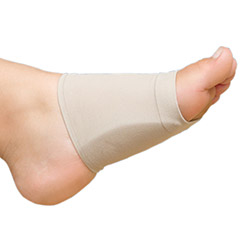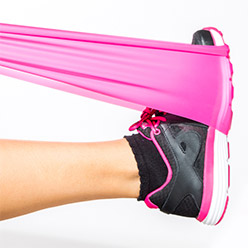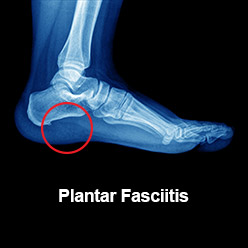Plantar fasciitis
Plantar fasciitis is a painful inflammation of the plantar fascia, a fibrous ligament that runs across the bottom of the foot and attaches the heel bone to the toes. The condition is usually caused by repetitive movements that stretch the fascia, resulting in small tears.

Symptoms
The most common symptom of plantar fasciitis is heel pain, usually in the morning. The pain can also come and go throughout the day, particularly after exercising.

Risk factors
In most cases, plantar fasciitis develops when the plantar fascia and heel are subjected to excess pressure. Here are the most common risk factors:
- Exercising without warming up or without the proper equipment
- Carrying excess weight (obesity or pregnancy), which leads to increased stress on the plantar fascia
- Wearing shoes with hard soles or heels (poor support for the arch of the foot and heel)
- Standing or walking on a hard surface for long periods of time
- Loss of flexibility starting at age 45
- Flat or hollow feet
- Diabetes or an inflammatory disease (e.g. rheumatoid arthritis)
Basic care
To avoid exacerbating plantar fasciitis once it occurs, reduce the physical activity that triggered the problem and consult a medical professional to get the appropriate care. Until then, here are a few ways to relieve the pain.
- Ice. Apply an ice bag or ice gel pack can help reduce inflammation. As soon as you start feeling pain, ice the area under the foot for fifteen minutes at a time, several times a day, every day. Be sure to raise your foot higher than your body during the treatment.
- Medications. Analgesics and anti-inflammatory drugs, such as ibuprofen, can be used to relieve pain. Do not use them for more than 2 to 3 days without consulting your family pharmacist.
If the pain persists, your doctor may decide to give you cortisone injections to further reduce the inflammation. - Support devices. In many cases, the most important form of treatment for plantar fasciitis is giving the foot proper support in order to rest the plantar fascia. Here are a few support devices that can help.

- Orthopedic soles and heel pads are cushions meant to be inserted into your shoes to provide good support as your foot structure strengthens.
- Sports bandage supports the arch to let your plantar fascia rest when you are stretching or practising a sport.
- Cast or splints can be worn to rest your plantar fascia.
Treatments and exercises
There are also specific exercises that help release muscle tension and, in turn, promote healing of the plantar fascia and prevent relapses.
Stretching exercises for calves, Achilles tendon and arches. Here are two suggestions:
- In a seated position, try to pick up a tissue on the floor with your toes. Repeat several times.
- Again in a seated position, place a towel under your foot and pull on each side to straighten your leg and create resistance.

Foot massages can be done before and after exercise to soften the plantar fascia.
Rehabilitation treatments involving a special exercise program designed for you by a physiotherapist can reduce tension in the fascia and in the connected muscles of the legs and pelvis.
Rest. Plantar fasciitis takes time to heal. As long as you have pain, you will need to reduce or even stop doing exercises that affect the support joints involved.
Surgery. Used as a last resort, surgery involves partially severing the plantar fascia to reduce strain. The intervention is not without risk, but has a success rate of 95 percent.
Heel spurs, a possible complication
Heel spurs, a potential complication of plantar fasciitis, are small bony growths that develop where the plantar fascia meets the heel bone. They occur in response to the extra strain placed on the fascia. Nearly half of those with plantar fasciitis will also have a heel spur.
Generally speaking, the pain attributed to a heel spur is due to the inflammation from plantar fasciitis. Once this is resolved, the heel spur will remain, but no pain will be present.

Pharmacy services
Your family pharmacist can recommend arch support devices and show you how to use them. Depending on the severity of your injury, he or she may also refer you to a doctor.
The pharmacy services presented in this section are offered by pharmacist owners who are affiliated with Uniprix. The pharmacists are solely responsible for the professional activities carried out during the practice of pharmacy. These services are offered in participating pharmacies only. Certain fees and conditions may apply.
* The information contained herein is provided for informational purposes only and is not intended to provide complete information on the subject matter or to replace the advice of a health professional. This information does not constitute medical consultation, diagnosis or opinion and should not be interpreted as such. Please consult your health care provider if you have any questions about your health, medications or treatment.
